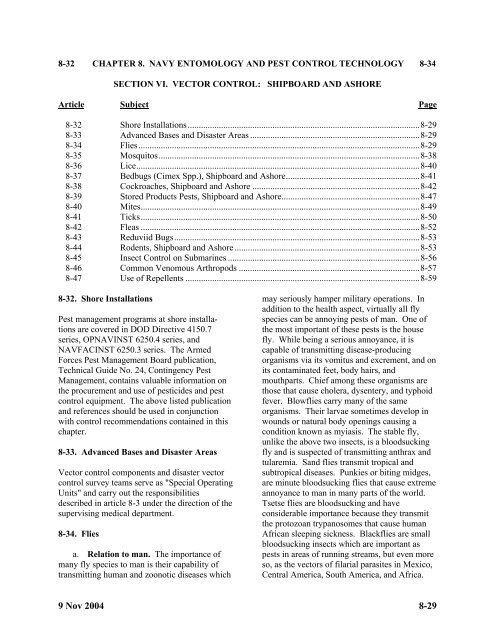NAVMED P-5010-8 - Navy Medicine - U.S. Navy
NAVMED P-5010-8 - Navy Medicine - U.S. Navy
NAVMED P-5010-8 - Navy Medicine - U.S. Navy
You also want an ePaper? Increase the reach of your titles
YUMPU automatically turns print PDFs into web optimized ePapers that Google loves.
8-32 CHAPTER 8. NAVY ENTOMOLOGY AND PEST CONTROL TECHNOLOGY 8-34<br />
SECTION VI. VECTOR CONTROL: SHIPBOARD AND ASHORE<br />
Article Subject Page<br />
8-32 Shore Installations........................................................................................................8-29<br />
8-33 Advanced Bases and Disaster Areas ............................................................................8-29<br />
8-34 Flies..............................................................................................................................8-29<br />
8-35 Mosquitos.....................................................................................................................8-38<br />
8-36 Lice...............................................................................................................................8-40<br />
8-37 Bedbugs (Cimex Spp.), Shipboard and Ashore............................................................8-41<br />
8-38 Cockroaches, Shipboard and Ashore ...........................................................................8-42<br />
8-39 Stored Products Pests, Shipboard and Ashore..............................................................8-47<br />
8-40 Mites.............................................................................................................................8-49<br />
8-41 Ticks.............................................................................................................................8-50<br />
8-42 Fleas .............................................................................................................................8-52<br />
8-43 Reduviid Bugs..............................................................................................................8-53<br />
8-44 Rodents, Shipboard and Ashore...................................................................................8-53<br />
8-45 Insect Control on Submarines ......................................................................................8-56<br />
8-46 Common Venomous Arthropods .................................................................................8-57<br />
8-47 Use of Repellents .........................................................................................................8-59<br />
8-32. Shore Installations<br />
Pest management programs at shore installations<br />
are covered in DOD Directive 4150.7<br />
series, OPNAVINST 6250.4 series, and<br />
NAVFACINST 6250.3 series. The Armed<br />
Forces Pest Management Board publication,<br />
Technical Guide No. 24, Contingency Pest<br />
Management, contains valuable information on<br />
the procurement and use of pesticides and pest<br />
control equipment. The above listed publication<br />
and references should be used in conjunction<br />
with control recommendations contained in this<br />
chapter.<br />
8-33. Advanced Bases and Disaster Areas<br />
Vector control components and disaster vector<br />
control survey teams serve as "Special Operating<br />
Units" and carry out the responsibilities<br />
described in article 8-3 under the direction of the<br />
supervising medical department.<br />
8-34. Flies<br />
a. Relation to man. The importance of<br />
many fly species to man is their capability of<br />
transmitting human and zoonotic diseases which<br />
may seriously hamper military operations. In<br />
addition to the health aspect, virtually all fly<br />
species can be annoying pests of man. One of<br />
the most important of these pests is the house<br />
fly. While being a serious annoyance, it is<br />
capable of transmitting disease-producing<br />
organisms via its vomitus and excrement, and on<br />
its contaminated feet, body hairs, and<br />
mouthparts. Chief among these organisms are<br />
those that cause cholera, dysentery, and typhoid<br />
fever. Blowflies carry many of the same<br />
organisms. Their larvae sometimes develop in<br />
wounds or natural body openings causing a<br />
condition known as myiasis. The stable fly,<br />
unlike the above two insects, is a bloodsucking<br />
fly and is suspected of transmitting anthrax and<br />
tularemia. Sand flies transmit tropical and<br />
subtropical diseases. Punkies or biting midges,<br />
are minute bloodsucking flies that cause extreme<br />
annoyance to man in many parts of the world.<br />
Tsetse flies are bloodsucking and have<br />
considerable importance because they transmit<br />
the protozoan trypanosomes that cause human<br />
African sleeping sickness. Blackflies are small<br />
bloodsucking insects which are important as<br />
pests in areas of running streams, but even more<br />
so, as the vectors of filarial parasites in Mexico,<br />
Central America, South America, and Africa.<br />
9 Nov 2004<br />
8-29
















